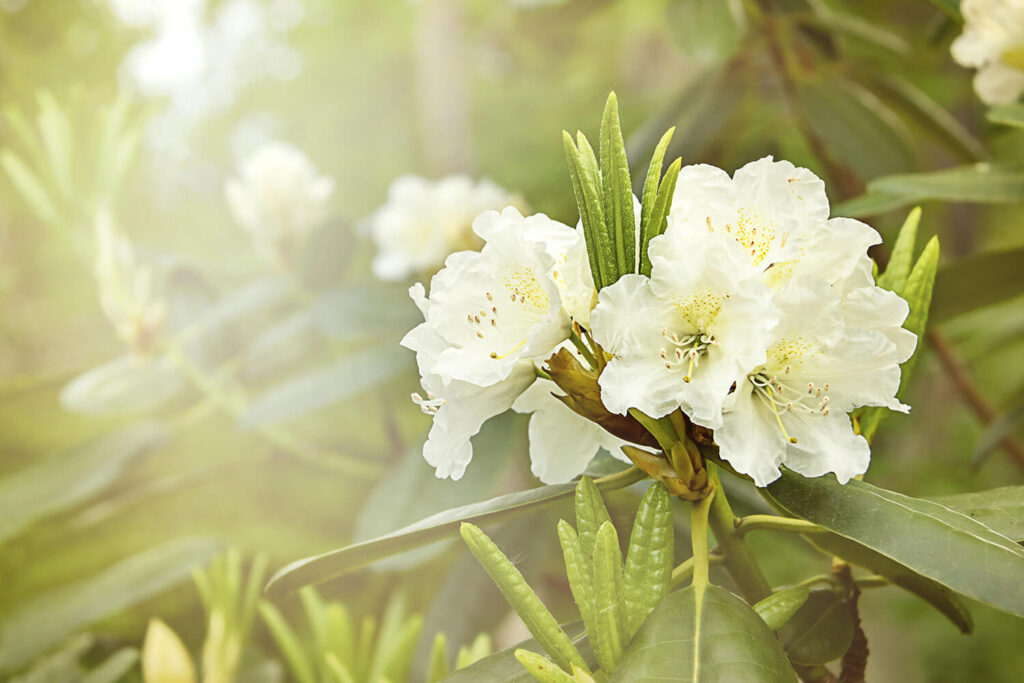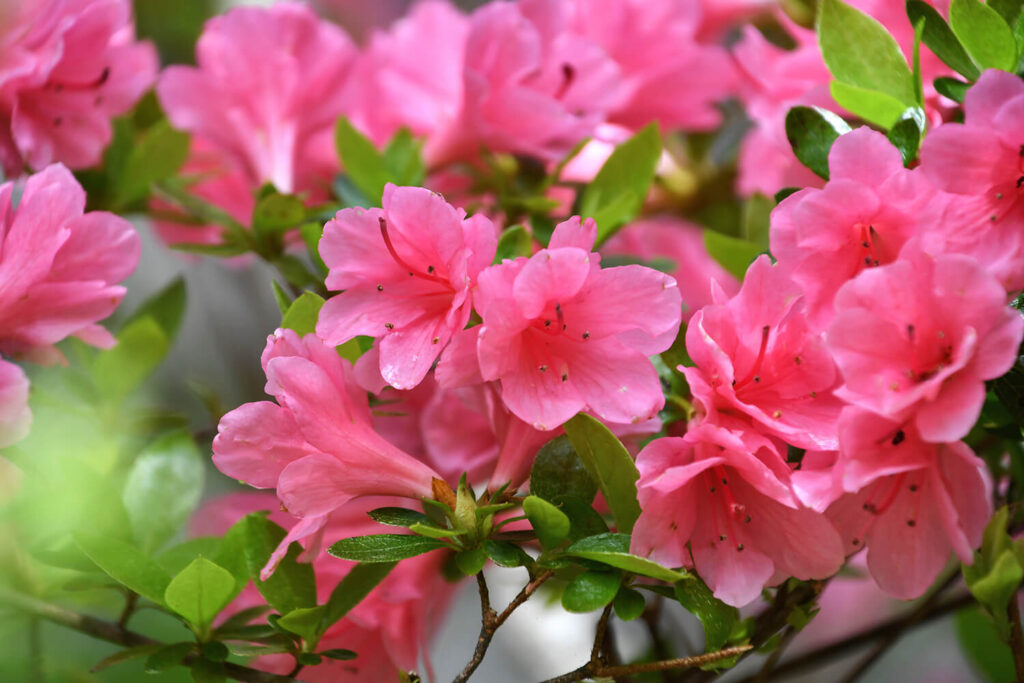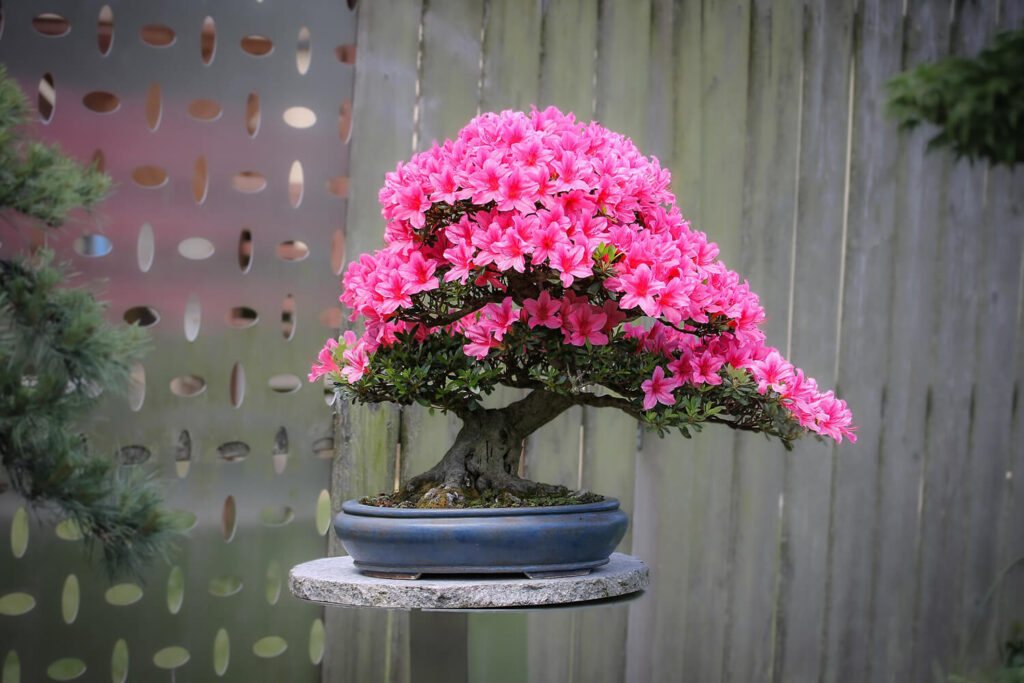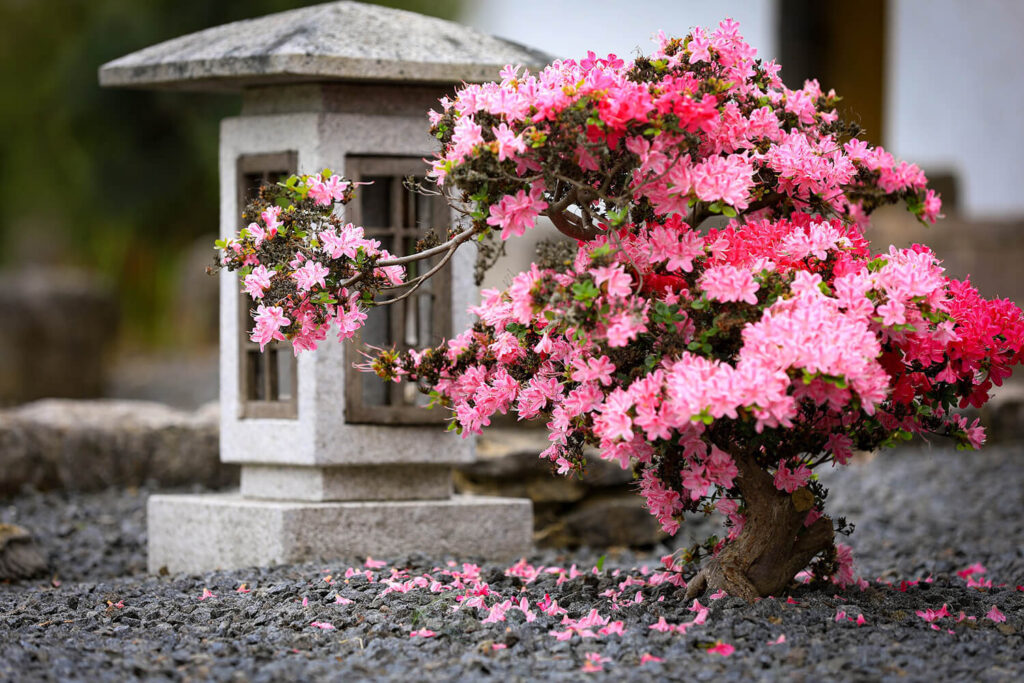Do you want to grow a bonsai tree that blooms eye-catching large, colorful flowers? Then, look into azalea bonsai trees.
Azaleas are popular for their gigantic flowers that last several weeks, making them one of the most sought-after bonsai specimens. Many enthusiasts cultivate this species mainly for its looks and hardiness. With that said…
Continue reading to discover:
- The nature and growth habits of an azalea plant.
- Two popular azalea cultivars used in bonsai growing.
- An all-inclusive yet beginner-friendly azalea miniature tree care guide.
- The best and quickest way to propagate azaleas for bonsai art.
- And so much more…
What is an Azalea Plant?
| Botanical name: | Rhododendron |
| Family: | Ericaceae (Heaths) |
| Tree type: | Broadleaf evergreen/deciduous shrub |
| Foliage type: | Simple with alternating leaf pattern |
| Growth habit: | Upright |
| Native habitat: | China and Thailand, but abundant in Asia, Europe, and North America |
| Distinctive feature: | Gigantic, colorful flowers |
Azaleas are one, if not the most, dramatic flowering shrubs in the world—thanks to their gigantic, bright color flowers that easily catch everyone’s attention. In fact, Japan celebrates special Azalea festivals every year to showcase its glamorous beauty to locals and tourists.
Depending on the cultivar, these flowers’ shape, color, size, and pattern vary. They can also appear anywhere from February to September, but most likely in late spring (May to June).
Although Azalea flowers come in various colors, white, pink, purple, and orange are some of the most popular hues you can find in most public gardens.

Clusters of Azalea white flowers
Clusters of Azalea pink flowers

These flowers can grow up to 7 inches in diameter and last for several weeks (about two to three weeks) if grown in favorable conditions.
Also, all Azalea cultivars have dark green leaves that differ in size and shape.
Azalea Cultivars Cultivated for Bonsai
There are about 100 species of this plant, but only a very few are suitable for Azalea miniature tree cultivation, specifically:
- Satsuki azalea (Rhododendron indicum)
- Kurume azalea (Rhododendron kiusianum & Rhododendron kaempferi)
These two azalea cultivars are evergreen, so they retain their leaves year-round.
Also, compared to other cultivars, Kurume and Satsuki azaleas are very hardy, adapt well to container cultivation, trunk up quicker, grow fine branches, respond well to root pruning, and have smaller leaf sizes that are perfect for miniature trees. They can also produce new buds on old wood, making them great beginner-friendly specimens.
The only obvious difference between Kurume and Satsuki azaleas is that the latter has slightly hairy leaves and produces two flowers on the ends of its terminals.
Trivia: “Satsuki” means “5th month” or “late spring” in Japanese, which in fact, is the flowering season of satsuki azaleas.
As bonsai, azaleas are styled in informal upright, slanting, windswept, semi-cascade, and root-over-rock forms.
Growing azaleas as bonsai (propagation azaleas)
The fastest and easiest way to propagate an azalea tree for bonsai is by cuttings. Take a softwood cutting in spring or early summer after flowering. Then plant it in healthy soil until it produces roots.
Depending on the cultivar, it can take 2.5 to 4 months before an azalea cutting can root. To encourage faster results, make sure to provide it with proper care and nourishment throughout the process.
How to Care for an Azalea Bonsai
Admiring the colorful flowers of azalea miniature trees is one thing, but actually taking time and effort to train and care for them is another.
If you want to add an azalea to your bonsai collection, read this azalea miniature tree care guide:
Quick general care guide for azalea miniature trees:
- Positioning: Outdoors year-round, but provide partial shade during hot days.
- Watering: Water using rainwater once the soil surface becomes slightly dry.
- Feeding: Fertilize during the growing season using azalea-specialized fertilizer.
- Pruning: Prune branches and remove flowers immediately after the flowering ends.
- Wiring: Heavy styling should be done before flower buds appear in the spring.
- Repotting: Repot in fresh soil every two years in spring or after flowering.
- Overwintering: Provide winter protection once the temperature drops below 40°F (4.4°C).
I. Positioning

Azalea plants are outdoor bonsai specimens, so they thrive being placed in a sunny spot outside.
However, during hot summer days, you must provide some shade as harsh direct sunlight can damage its roots and cause its flowers to fade colors. You can do that by placing a shade cloth over your azalea miniature tree.
Also, protect your bonsai from heavy rain by moving it to a shaded area, especially during flowering, to avoid damaging its delicate blossoms.
II. Watering
A Satsuki azalea bonsai doesn’t like prolonged drought and permanent wetness. With that said, only water when needed—once the soil becomes slightly dry.
Also, when doing so, make sure to water generously and that the entire root system is watered. Continue to pour water onto it until the water runs out of the pot’s drainage holes.
Type of water to use
Azalea miniature tree specimens thrive in slightly acidic soil, so use rainwater when watering them.
Suppose you don’t have enough rainwater supply. Here’s what you can do:
- Mix rainwater with hard tap water.
- Filter your hard tap water using any filtering system.
- Mix 1 tablespoon of white vinegar to every gallon of hard water once a month to adjust its pH value.
Watering azaleas based on the season
Depending on the season, the water needs of your Kurume or Satsuki azalea miniature tree may increase or decrease.
To help you out, here’s how you should water your azalea miniature tree by season:
A. In spring
Most Satsuki azalea miniature tree bloom in spring, so be careful when watering them to avoid damaging the flowers or flower buds. Pour water from the top of the soil surface.
If watering the foliage is needed, use a regular spray bottle to mist them.
B. In summer
As the temperature rises, your watering frequency should also increase. Water your azalea miniature tree at least twice a day.
Suppose you left your bonsai underwatered for several days or weeks. Dunk its entire root ball in a bowl of water for several seconds to thoroughly water it. However, don’t do it regularly, as this can result in root rot disease that can weaken your bonsai.
C. In autumn and winter
Decrease your watering seasons during these months to prevent overwatering your Satsuki azalea miniature tree—only water when necessary.
III. Fertilizing
Fertilize your azalea miniature tree during the growing season but in varying dosages.
Use a fertilizer specifically formulated for azalea, which is lime-free, to ensure proper and beautiful growth of its flowers. You can also partner it with azalea-specific liquid fertilizer for a more boosting and balanced effect.
Feeding azaleas based on their needs
Adjusting your fertilizing frequency and dosages is necessary to ensure proper growth and development. That being said, here’s how you should fertilizer your Kurume or Satsuki azalea miniature tree based on its needs:
A. For health enhancement
You can start fertilizing in early spring to boost new shoots and better leaf growth. Then, use half a dosage or quit altogether once the flowering starts to avoid losing its blossoms.
B. For general development and refinement
Apply a bonsai fertilizer with high phosphorus and potassium content, especially during late summer or early fall, to encourage more flowering.
IV. Pruning

Azalea specimens withstand strong pruning very well, plus they grow new shoots on bald areas—making them a great tree to practice by beginners.
This species is basally-dormant, meaning the lower part tends to grow stringer, so you have to prune the lower branches more frequently and harder than the top half. You should prune yearly growth immediately after the blossoming ends. Otherwise, you’ll risk your tree producing less or no flowers in the next season.
Note: Other pruning jobs, such as removing unwanted shoots, can be done anytime.
It’s also important to remove dead flowers, including all the flowers still attached to the tree, once the flowering period ends to prevent them from forming seed pods, which can sprout new leaves.
V. Wiring and Bending
The best time to wire and extensively style your bonsai tree is in the spring before the blooms appear. However, you can do light wiring anytime but with caution, especially because azalea trees have tender bark and brittle branches.
Use an aluminum bonsai wire on your bonsai, and wrap it tightly at a 45 to 50 degrees angle for best support. Wrapping raffia strips around old branches may also be necessary when bending heavily.
Watch this video of a year-long development of azalea flower pads:
VI. Repotting
Generally, you should repot your Azalea bonsai tree every two years before or after flowering—but best in early spring.
If repotting before the blooms appear, remove all the flower buds to avoid strain on the tree, as each flower consumes energy. Suppose some flowers start to open too soon, pinch off 2-3 largest buds to slow down their development.
Root pruning
Azalea specimens can withstand substantial root pruning, so feel free to trim their roots to control their growth and development better. Doing this is also necessary to treat root rot-damaged parts on the root system.
Note: Be gentle when pruning roots as they are thin and matted, making them susceptible to tearing.
To do that, cut the bottom of the root ball into a cone shape. This technique helps give space for the roots to breathe, improving aeration and drainage later on.
Soil requirements
Since azalea trees like slightly acidic soil, use specialized lime-free azalea soil.
One of the highly-recognized good azalea soil is pure kanuma soil from Japan, as it’s very acidic and promotes good drainage and aeration.
VII. Winter Care
Mature, healthy azaleas can endure temperatures close to freezing, particularly 40°F (4.4°C). Once the temperature falls below that range, provide winter protection on your bonsai.
You can either:
- Mulched it up to the rim of the pot.
- Move it to a cold frame or greenhouse.
- Place in an unheated room, such as a garage.
Warning: Mice and rabbits find the bark of azalea trees tasty, so make sure to position your bonsai tree in a safe area.
VIII. Pests and Diseases
Pests do not often infest azalea species. However, if not cared for properly, they can suffer from the following:
- Whiteflies
- Vine weevil
- Caterpillars
- Spider mites
- Aphids or scales
- Bud Blast or Petal blight
- Lime-included chlorosis
- Fungal diseases, such as leaf galls or rust
- Mildew that produces a white powdery substance
Low humidity, poor nourishment, and improper care can invite these pests and diseases onto your tree.
Fortunately, you can easily remove and treat them by spraying special pesticides, insecticides, or fungicides at a proper dosage. Improving the living conditions of your bonsai also helps improve its health.
Warning: Avoid spraying treatments directly on open flowers, as these can cause them to wilt or fall.
Conclusion
Azalea bonsai trees are stunning specimens that can give life and color to your bonsai garden. As long as you provide it with proper care and maintenance, it can continue to produce awe-striking gigantic flowers for several years.
So, if you want to grow one, equip yourself with the right bonsai knowledge and skills!
If you’re looking to expand your bonsai knowledge about different tree species, our website is the perfect spot for that!





This was very informative. I am a beginner and I watched the video and was very impressed with the information that was provided. Thank you so very much for sharing this with me.
Hi Donna – so glad you enjoyed it!